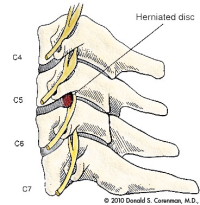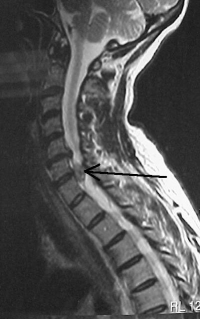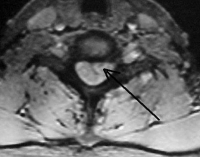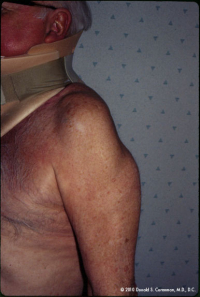Cervical Spine Herniated Disc Overview
A herniated disc (cervical spine) is a common condition that can lead to a considerable amount of neck, shoulder, arm and hand pain. The most common symptom, is neck pain in the back of the neck.
What is a Disc Injury?
To understand the cervical spine is to understand the anatomy of the cervical spine. Discs, which are sandwiched between the vertebrae, act as the spine’s protective shock absorbers. In essence, they are like a jelly-filled donut that contains the annulus (the outside of the donut) that surrounds the nucleus pulposus (the gel-like substance within the donut). The annulus is made up of about 30 layers that act just like the plies of a tire. If some of these plies break or tear, just like taking a cap off a toothpaste tube and squeezing the tube, the gel-like substance inside can squeeze out. This extrusion of jelly is the actual herniated disc which leads to neck pain. Causes of a herniated disc (which people sometimes call a pinched nerve in the neck) are often the wear and tear and degeneration of the discs that reside in the spine.
This herniated disc material can ultimately put pressure on nerve roots which live right next to the disc and occasionally on the spinal cord itself. In addition, the substance that makes up this gel (the nucleus) also contains substances that are toxic to nerves. Why God or Mother Nature designed the disc this way is anybody’s guess. This toxic substance can cause inflammation within the nerve, which can lead to arm pain and numbness even without direct compression of the nerve itself.
If the herniated disc (cervical spine) compresses a nerve root, pain from nerve compression will normally develop down the arm into the shoulder or to the hand (depending upon the nerve root involved). This is caused by an inflammation of the cervical spinal cord (called radiculopathy). If the herniation compresses the spinal cord it is called myelopathy and information on this condition is found in another section on this web site.
Cervical Spine Herniated Disc Symptoms
Depending upon the position of the disc herniation, cervical spine herniated disc symptoms may cause neck pain in the back of the neck, sides, in the shoulder, arm or hand. Common symptoms are pain and numbness or occasionally just weakness of the muscles of the nerve that is compressed. Depending on the nerve, pain may radiate only into the shoulder or may radiate down the arm into the fingers. Almost all cervical spine herniations radiate pain into the shoulder blade on the side of the herniation.
There are many patients that have pain that radiates only to the area between the shoulders and these symptoms are commonly misdiagnosed as thoracic or scapular (shoulder blade) pain when the pain is really referral pain from the compressed nerve in the neck. Likewise, patients may assume they have a simple pinched nerve in the neck when really it is the compression that is leading to the neck pain. Causes of these various symptoms can be revealed by an x-ray of the cervical spine region.
If present muscle weakness may not be revealed unless the individual lifts weights and is familiar with which muscles are used with different positions. Sometimes, the weakness is significant and disabling. Other times, just feeling clumsy and dropping objects can be a symptom of weakness.

(Click to Enlarge Image) This illustration is a side view of the cervical spine (neck). Here you can see the vertebral bodies with the discs in the front of the spine and the facets in the rear. The nerve roots exit through the sides of the spine.

(Click to Enlarge Image) This is a side view (sagittal) MRI of a large disc herniation in the cervical spine (neck). The arrow points to the herniation.
Are you suffering from symptoms of a cervical spine herniated disc?
Would you like to consult with Dr. Corenman about your condition?
You can set up a long distance consultation to discuss your
current X-rays and/or MRIs for a clinical case review.
(Please keep reading below for more information on this condition.)
Biomechanics
While most patients may assume that they have a pinched nerve in the neck, the reality for most is that they have a cervical spine herniated disc. The biomechanics of a herniated disc are easy to understand. The nerve hole itself becomes larger with bending the head forward and away from the side that it is on. Bending the head backwards or to the side that the nerve hole or foramen is on will narrow the hole. Therefore, with a herniated disc, arm and shoulder pain will normally become worse with bending backwards or to the side of the arm pain as this maneuver causes further compression to the nerve. Obviously avoid any head motions that increase the pain into the arm, as it is not a good idea to crush this nerve any further.
Most of the varying herniations will cause moderate discomfort to intense pain in the shoulder, neck and upper back area depending on the location of the herniation. The most common symptoms are a dull, nagging pain in the neck or between the shoulder blades. This pain will become more intense if the patient bends the neck backwards (this narrows the hole the nerve lives in) or with lifting or exercising. Some activities can be more painful (bike riding with a low stem and swimming can extend the neck causing increased pain).
Cervical Spine Herniated Disc Treatment
Non-Surgical
Medications, injection therapies, physical therapy and rest can relieve the symptoms of a herniated disc cervical spine. If the symptoms persist or the weakness is significant, then surgery may be recommended.
Surgical
The best surgery to treat a herniated disc in the cervical spine is an anterior cervical decompression and fusion (ACDF). This surgery for a herniated disc is explained in one of Dr. Corenman’s educational videos. With this surgery, the offending torn disc is removed, the nerve root pressure can be relieved and the segment stabilized with a fusion. This procedure can be performed microscopically which will use a smaller incision and leads to a faster recovery. There are times that the fragment can be removed posteriorly in a procedure called a posterior cervical foramenotomy. (See surgical section for information on both procedures.)
An artificial disc can be implanted to allow motion to continue after surgery. There are risks and benefits of this procedure. (See the section on cervical artificial disc surgery). Neck pain causes patients to miss work and stop the activities they love most. It’s important to get an accurate diagnosis so that the symptoms associated with this pain can be resolved.
For additional resources on a cervical spine herniated disc, or to discuss treatment options, please contact the office of Dr. Donald Corenman, neck doctor and spine specialist offering diagnostic and surgical second opinions to patients in the USA and around the world.
Related Content
- Cervical Radiculopathy or Pinched Nerve in the Neck
- Arthritis of the Neck and Back
- Cervical Deformity
- Cervical Degenerative Kyphosis
- Cervical Degenerative Spondylolisthesis
- Cervical Central Stenosis & Myelopathy
- Chronic Radiculopathy
- Cervical Degenerative Disc Disease
- Cervical Degenerative Facet Disease


